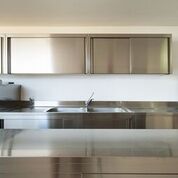As coronavirus spreads, Auburn professor comments on importance of interior design for disease containment
Article body
As authorities around the world work to prevent the spread of the coronavirus, Auburn University College of Human Sciences Associate Professor and Interior Design Program Coordinator Lindsay Tan discusses how the design of certain places can affect the disease’s transmission. Tan leads the Design Ecology Lab and the newly established College of Human Sciences Pathogen Lab, in which students will investigate how disease-causing pathogens are spread throughout indoor environments. In the wake of the alarm over the coronavirus, Tan said there are design elements that can help contain the outbreak.
Why is it important to consider interior design in disease prevention?
We spend more than 90 percent of our time indoors. Our health is influenced by everything we touch in these interior environments. Disease-causing pathogens can be transferred from person to person, but also through everyday objects—the waiting room chairs at the doctor’s office, the door handle to the breakroom at work, the clipboard passed around at a volunteer event. Being exposed to common viruses and bacteria in this way can help to build up our immune system. When it comes to more severe diseases, though, it is critical to have interior environments that can protect our health by reducing pathogen transmission.
What are we learning about the role of design in the current coronavirus outbreak?
Coronaviruses are a large family of viruses. Some can cause familiar illnesses like the common cold but some also cause more severe diseases like SARS – Severe Acute Respiratory Syndrome. The current coronavirus outbreak is caused by one member of this family that we’ve never seen before, and that means that we don’t necessarily have all the answers about how this novel virus behaves. Based on what we know so far, one of the ways the virus can be spread is by touching contaminated surfaces. We touch a lot of surfaces in our day-to-day life, and the Centers for Disease Control and Prevention, or CDC, are advising the public to follow some commonsense practices like washing hands and avoiding touching your eyes, nose and mouth.
Designers also play a key role in outbreaks like this. Some materials transfer pathogens more effectively than others. Some materials are even inherently antimicrobial, meaning they can weaken or kill the disease-causing organism before it can infect anyone. Biosecurity measures during an outbreak like the one we are seeing now will make use of antimicrobial materials, personal protective equipment, thorough cleaning routines and vigilant waste management to reduce the risk of the virus spreading.
How does the current outbreak relate to your research?
By 2050, 75 percent of the global population will be living in cities. High density populations like these make us all more susceptible to threats like disease outbreaks, food and water shortages and extreme weather events – not to mention intentional attacks. The growing urban population presents what we call a “wicked problem” – one that is multilayered and complex, and can’t be fixed with one magical solution. As a design ecologist, my research involves mapping wicked problems like this across the framework of the built environment to find and implement design interventions – alterations to protect health and improve quality of life. The novel coronavirus COVID-19 provides us with a case study of how the built environment – hospitals, airplanes, cruise ships – play a central role in a disease outbreak.
Can you give us a specific example of the role interiors have played in the outbreak?
The Diamond Princess is a British luxury cruise ship that was quarantined on Feb. 5, along with almost 3,700 passengers and crew, at a dock in Yokohama, Japan. Cruise ship rooms are relatively small; the interior rooms of the Diamond Princess are advertised as being approximately 158 to 162 square feet in size – that’s just a little bit bigger than four single-person handicap-accessible restrooms – but with all of the amenities you would expect in a luxury room. That’s a lot of surfaces to clean in a very small space. And when someone in that room is sick, they are breathing and sneezing and coughing on all of those surfaces.
In hospital rooms, which are also relatively small, interior designers choose materials that can be easily cleaned and sterilized – materials like sheet vinyl floors with rolled edges, laminated countertops and stainless steel sinks with offset drains. We have much more rigorous cleaning protocols, too. In spaces designed to handle infectious diseases, we even install specialized air filtration and pressurization systems to ensure that harmful agents cannot move from room to room.
On a cruise ship, though, staff are not necessarily trained in the same biosecurity protocols. Interior designers choose materials for their durability and aesthetic appeal and not necessarily for antimicrobial properties. Some carpets and fabrics are able to be sterilized, yes, but the ones selected for a luxury hospitality space are not necessarily the same ones we would choose if we were designing specifically to protect against infectious agents. The air filtration system and the waste management system on a cruise ship are not designed to do what the specialized systems in hospitals can do. In essence, the Diamond Princess and its crew are being asked to provide all the services of a luxury cruise ship experience as well as perform all the functions of an isolation ward in a hospital – in a space that was never designed to work like that. The fact that they have been so effective on both fronts is a testament to the dedication of the crew.
This case serves to remind us why interior designers and other professionals of the built environment – apparel designers, architectural designers and product designers – must always look beyond the obvious, to anticipate risks and respond to threats through better designs that proactively protect our health and safety.
What advice do you have for the public?
I’m a design ecologist – not a disease ecologist – so as a member of the public, I turn to the Centers for Disease Control and Prevention, or CDC. The CDC will continue to provide the most up to date information on the virus to the public, including recommendations for preventing infection and guidance on seeking proper medical attention if you might be infected. More information can be found on the CDC’s website: https://www.cdc.gov/coronavirus/2019-ncov/
Auburn University is a nationally ranked land grant institution recognized for its commitment to world-class scholarship, interdisciplinary research with an elite, top-tier Carnegie R1 classification, life-changing outreach with Carnegie’s Community Engagement designation and an undergraduate education experience second to none. Auburn is home to more than 30,000 students, and its faculty and research partners collaborate to develop and deliver meaningful scholarship, science and technology-based advancements that meet pressing regional, national and global needs. Auburn’s commitment to active student engagement, professional success and public/private partnership drives a growing reputation for outreach and extension that delivers broad economic, health and societal impact.






